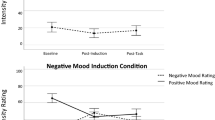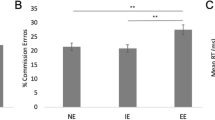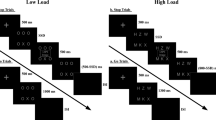Abstract
The ability to inhibit affective information plays a major role in efficient cognitive processing. In this study the effect of mood induction on inhibitory processing of emotional material was investigated. In Experiment 1, performance on a negative affective priming task (NAP) following negative and positive mood induction (MIP) was compared to a neutral mood condition. Results revealed that, as compared with the neutral mood condition, inhibitory function for affective material was unaffected by negative MIP. However, after the positive MIP, inhibitory processes were significantly impaired. In Experiment 2, we replicated and extended the findings on positive affect and inhibition. The data concerning positive mood fit with the general findings that positive mood often leads to a “loose, flexible” processing mode. The null-finding concerning negative mood and inhibition is discussed in the light of research on inhibition in depression.


Similar content being viewed by others
References
Aspinwall, L. G. (1998). Rethinking the role of positive affect in self-regulation. Motivation and Emotion, 22, 1–32.
Beck, A. T., Steer, R. A., & Brown, G. K. (1996). Manual for the Beck depression inventory (2nd ed.). San Antonio, TX: The Psychological Corporation.
Bradley, B. P., Mogg, K., & Lee, S. C. (1997). Attentional biases for negative information in induced and naturally occurring dysphoria. Behavior Research and Therapy, 35, 911–927.
Bradley, B. P., Mogg, K., White, J., Groom, C., & de Bono, J. (1999). Attentional bias for emotional faces in generalized anxiety disorder. British Journal of Clinical Psychology, 38, 267–278.
Braunstein-Bercovitz, H. (2003). Does stress enhance or impair selective attention? The effects of stress and perceptual load on negative priming. Anxiety Stress and Coping, 16, 345–357.
Crowne, D. P., & Marlowe, D. (1960). A new scale of social desirability independent of psychopathology. Journal of Consulting Psychology, 24, 349–354.
De Raedt, R., D’Haenen, H., Everaert, H., Cluydts, R., & Bossuyt, A. (1997). Cerebral blood flow related to induction of a depressed mood within and out of the realm of attention in normal volunteers. Psychiatry Research-Neuroimaging, 74, 159–171.
Dreisbach, G., & Goschke, T. (2004). How positive affect modulates cognitive control: Reduced perseveration at the cost of increased distractibility. Journal of Experimental Psychology: Learning, Memory and Cognition, 30, 343–353.
Ekman, P. (1993). Facial expression and emotion. American Psychologist, 48, 384–392.
Ellis, H. C., & Ashbrook, T. W. (1988). Resource allocation model of the effects of depressed mood state on memory. In K. Fiedler, & J. P. Forgas (Eds.), Affect, cognition and social behavior (pp. 25–43). Toronto: Hogrefe.
Estrada, C. A., Isen, A. M., & Young, M. J. (1994). Positive affect improves creative problem-solving and influences reported source of practice satisfaction in physicians. Motivation and Emotion, 18, 285–299.
Fazio, R. H. (1990). On the value of basic research – an overview. Personality and Social Psychology Bulletin, 16, 5–7.
Fiedler, K. (1988). Emotional mood, cognitive style, and behavior regulation. In K. Fiedler, & J. P. Forgas (Eds.), Affect, cognition and social behavior (pp. 100–119). Toronto: Hogrefe.
Fredrickson, B. L. (2001). The role of positive emotions in positive psychology: The broaden-and -build theory of positive emotions. American Psychologist, 56, 218–226.
Fredrickson, B. L., & Branigan, C. (2005). Positive emotions broaden the scope of attention and thought-action repertoires. Cognition & Emotion, 19, 313–332.
Gasper, K., & Clore, G. L. (2002). Attending to the big picture: Mood and global versus local processing of visual information. Psychological Science, 13, 34–40.
Gerrards-Hesse, A., Spies, K., & Hesse, F. W. (1994). Experimental inductions of emotional states and their effectiveness – a review. British Journal of Psychology, 85, 55–78.
Goeleven, E., De Raedt, R., Baert, S., & Koster, E. H. W. (2006a). Deficient inhibition of emotional information in depression. Journal of Affective Disorders, 93, 149–157.
Goeleven, E., De Raedt, R., Leyman, L., Verschuere, B. (2006b). The Karolinska directed emotional faces: A validation study (submitted).
Hasher, L., Lustig, C., & Zacks, R. T. (2007). Inhibitory mechanisms and the control of attention. In A. Conway, C. Jarrold, M. Kane, A. Miyake, & J. Towse (Eds.), Variation in working memory. Oxford: University Press.
Hasher, L., & Zacks, R. T. (1988). Working memory, comprehension and aging: A review and a new view. In G. H. Bower (Ed.), The psychology of learning and motivation (pp. 193–225). San Diego, CA: Academic Press.
Hewig, J., Hagemann, D., Seifert, J., Gollwitzer, M., Naumann, E., & Bartussek, D. (2005). A revised film set for the induction of basic emotions. Cognition & Emotion, 19, 1095–1109.
Inquisit 1.33 (2005). Seattle, WA: Millisecond Software.
Isen, A. M. (2001). Some perspectives on positive affect and self-regulation. Psychological Inquiry, 11, 184–187.
Isen, A. M., Daubman, K. A., & Nowicki, G. P. (1987). Positive affect facilitates creative problem-solving. Journal of Personality and Social Psychology, 52, 1122–1131.
Joormann, J. (2004). Attentional bias in dysphoria: The role of inhibitory processes. Cognition & Emotion, 18, 125–147.
Joormann, J. (2006). Differential effects of rumination and dysphoria on the inhibition of irrelevant emotional material: Evidence from a negative priming task? Cognitive Therapy and Research, 30, 149–160.
Joormann, J., & Siemer, M. (2004). Memory accessibility, mood regulation, and dysphoria: Difficulties in repairing sad mood with happy memories? Journal of Abnormal Psychology, 113, 179–188.
Josephson, B. R., Singer, J. A., & Salovey, P. (1996). Mood regulation and memory: Repairing sad mood with happy memories. Cognition & Emotion, 10, 437–444.
Kuhl, J., & Kazen, M. (1999). Volitional facilitation of difficult intentions: Joint activation of intention memory and positive affect removes Stroop interference. Journal of Experimental Psychology: General, 128, 382–399.
Lang, P. J., Bradley, M. M., & Cuthbert, B. N. (1997). Motivated attention: Affect, activation and action. In P. J. Lang, R. F. Simons, & M. T. Balaban (Eds.), Attention and orienting: Sensory and motivational processes (pp. 97–135). Hillsdale, NJ: Erlbaum.
Linville, P. (1996). Attention inhibition: Does it underlie ruminative thought? In R. S. Wyer Jr. (Ed.), Ruminative thoughts. Advances in social cognition. Mahwah, NJ: Lawrence Erlbaum.
Lundqvist, D., Flykt, A., & Öhman, A. (1998). The Karolinska directed emotional faces – KDEF. CD ROM from Department of Clinical Neuroscience, Psychology Section, Karolinska Institutet, ISBN 91-630-7164-9.
May, C. P., Kane, M. J., & Hasher, L. (1995). Determinants of negative priming. Psychological Bulletin, 118, 35–54.
McNair, D. M., Lorr, M., & Droppelman, L. F. (1971). Manual for the profile of mood states. San Diego, CA: Educational and Industrial Testing Services.
Neill, W. T., & Valdes, L. A. (1992). Persistence of negative priming: Steady state or decay? Journal of Experimental Psychology: Learning, Memory, and Cognition, 18, 565–576.
Nolen-Hoeksema, S. (1991). Responses to depression and their effect on the duration of depressive episodes. Journal of Abnormal Psychology, 100, 569–582.
Oaksford, M., Morris, F., Grainger, B., & Williams J. M. G. (1996). Mood, reasoning, and central executive processes. Journal of Experimental Psychology: Learning, Memory and Cognition, 22, 476–492.
Polivy, J., & Doyle, C. (1980). Laboratory induction of mood states through the reading of self-referent mood statements: Affective changes or demand characteristics? Journal of Abnormal Psychology, 89, 286–290.
Posner, M. I., Inhoff, A., Friedrich, F. J., & Cohen, A. (1987). Isolating attentional systems: A cognitive-anatomical analysis. Psychobiology, 15, 107–121.
Schmukle, S. C., Egloff, B., & Burns, L. R. (2002). The relationship between positive and negative affect in the positive and negative affect schedule. Journal of Research in Personality, 36, 463–475.
Seibert, P. S., & Ellis, H. C. (1991). Irrelevant thoughts, emotional mood states, and cognitive task performance. Memory & Cognition, 19, 507–513.
Skosnik, P. D., Chatterton, R. T., Swisher, T., & Park, S. (2000). Modulation of attentional inhibition by norepinephrine and cortisol after psychological stress. International Journal of Psychophysiology, 36, 59–68.
Spruyt, A., Hermans, D., De Houwer, J., & Eelen, P. (2002). On the nature of the affective priming effect: Affective priming of naming responses. Social Cognition, 20, 227–256.
Stroop, J .R. (1935). Studies of interference in serial verbal reactions. Journal of Experimental Psychology, 18, 643–662.
Teasdale, J. D. (1999). Emotional processing, three modes of mind and the prevention of relapse in depression. Behaviour Research and Therapy, 37, S53–S77.
Tipper, S. P. (1985). The negative priming effect: Inhibitory processes by ignored objects. Journal of Experimental Psychology, 37, 571–590.
van der Ark, L. A., Marburger, D., Mellenbergh, G. J., Vorst, H. C. M., & Wald, F. D. M. (2003). Verkorte profile of mood states (Verkorte POMS): Handleiding en verantwoording [Shortened profile of mood states: Manual and justification]. Lisse: Swets & Zeitlinger B.V.
van der Does, A. J. W. (2002). De Nederlandse versie van de Beck depression inventory – Tweede Editie. [The Dutch version of the Beck depression inventory – Second edition]. Lisse: Swets & Zeitlinger B.V.
Velten, E. (1968). A laboratory task for induction of mood states. Behavior Research and Therapy, 6, 473–482.
Wald, F. (1984). De verkorte POMS [The shortened POMS]. Amsterdam: Onuitgegeven doctoraalwerkstuk, vakgroep psychonomie, psychologisch laboratorium, Universiteit van Amsterdam.
Watson, D., Clark, L. A., & Tellegen, A. (1988). Development and validation of brief measures of positive and negative affect: The PANAS scales. Journal of Personality and Social Psychology, 54, 1063–1070.
Weary, G., Marsh, K. L., Gleicher, F., & Edwards, J. A. (1993). Depression, control motivation, and the processing of information about others. In G. Weary, F. Gleicher, & K. L. Marsh (Eds.), Control motivation and social cognition (pp. 255–287). New York: Springer.
Wentura, D. (1999). Activation and inhibition of affective information: Evidence for negative priming in the evaluation task. Cognition & Emotion, 13, 65–91.
Westermann, R., Spies, K., Stahl, G., & Hesse, F. W. (1996). Relative effectiveness and validity of mood induction procedures: A meta-analysis. European Journal of Social Psychology, 26, 557–580.
Williams, J. M. G., Mathews, A., & MacLeod, C. (1996). The emotional stroop task and psychopathology. Psychological Bulletin, 120, 3–24.
Wright, J., & Mischel, W. (1982). Influence of affect on cognitive social learning person variables. Journal of Personality and Social Psychology, 43, 901–914.
Acknowledgement
Funded by the Special Research Fund of Ghent University (Belgium).
Author information
Authors and Affiliations
Corresponding author
Rights and permissions
About this article
Cite this article
Goeleven, E., De Raedt, R. & Koster, E.H.W. The influence of induced mood on the inhibition of emotional information. Motiv Emot 31, 208–218 (2007). https://doi.org/10.1007/s11031-007-9064-y
Received:
Accepted:
Published:
Issue Date:
DOI: https://doi.org/10.1007/s11031-007-9064-y




